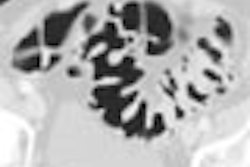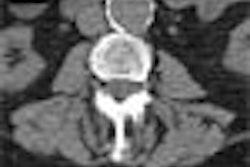Pity the radiologist with a brand-new multislice CT scanner. First there are jealous colleagues to deal with, and then an increasing number of scan parameters to juggle. The 4-, 8-, and now 16-detector-row CT scanners making their way into imaging offer exciting new applications and diagnostic possibilities. But excitement can turn to overload when the radiologist has too many choices to make.
At last week's International Symposium on Multidetector-Row CT in San Francisco, Dr. Geoffrey Rubin sought to simplify matters in a presentation that discussed the tradeoffs involved in designing CT protocols.
"There are so many choices," said Rubin, who is chief of cardiovascular imaging and associate professor of radiology at Stanford University Medical School in Stanford, CA. "We can pick section thickness, table speed, pitch, rotation speed, number of rows, kVp and mA, all independently -- keeping in mind the x-ray dose at the same time. This is a big challenge for us, and it can be rather daunting."
Protocol building blocks
There is table speed, which controls the length of time required to complete the acquisition. It can be calculated by multiplying scan pitch by the x-ray beam width divided by the gantry rotation time, or: table speed = pitch x beam width ÷ gantry rotation time, Rubin said.
Gantry rotation time varies from about one-half second to two seconds. It has a linear relationship with table speed, so both values affect scan duration equally. Tube current multiplied by gantry rotation time equals the mA value.
Rotation time should generally be as fast as possible, except when imaging obese patients. There is generally no downside to faster rotation, as long as mA rises to compensate, Rubin said.
Pitch is the product of table speed and gantry rotation time divided by the beam width, or: pitch = table speed x gantry rotation time ÷ beam width. The beam width divided by the number of detector rows equals the narrowest reconstructable section.
Considered alone, increasing the pitch has little effect on image acquisition, except to increase helical artifacts, Rubin said.
"There have not been any papers published indicating the limitations of helical artifacts on making diagnosis," he said. "One can demonstrate a dropoff in image quality, particularly in 3-D views. But when you have a scanner that allows you to maintain section thickness regardless of pitch, then pitch becomes irrelevant."
However, manufacturers treat pitch in different ways. On some scanners, reducing pitch reduces radiation exposure as the tube current is held constant. Other scanners increase the x-ray tube current as pitch is increased, negating the possibility of reducing dose in this manner. Rubin favors scanners with more choices.
The x-ray beam width, which may or may not be selectable, can be derived from pitch, table speed, and gantry rotation. The important thing to remember is that the width of individual detector elements defines the minimum section thickness that can be reconstructed on MDCT scanners -- but thicker sections can certainly be reconstructed as well, Rubin said.
Rubin approaches protocol design with a series of questions, asked in a specific order:
- What's the thinnest section that might be useful for a given scan?
- How fast does the scan need to be?
- What strategy offers the lowest dose for the diagnostic question at hand?
- To what extent will noise inhibit the evaluation?
Section thickness
The issue here is whether the radiologist anticipates the need to detect and measure very small structures, Rubin said. For example, the ability to reconstruct thin sections is crucial for characterizing pulmonary nodules, but less important for evaluating abdominal trauma.
A routine thoracic CT requires the ability to retrospectively review suspicious areas with thin sections such as 1.25-mm-thick reconstructions. The radiologist must anticipate this need in advance, and acquire the images with a 1- or 1.25-mm detector element. (Beam width: 4-5 mm on a 4-detector row system; 16-20-mm on a 16-row scanner.)
True, acquisition at 4 x 1.25-mm takes 4 times as long as a 4 x 5-mm scan, but it's the only way to get thin slices later. And there is also a slight noise penalty to keep in mind when creating thinner sections while keeping dose constant, Rubin said.
"There's a direct tradeoff," he said. "If you think you're going to want to retrospectively go back and get thinner sections, then it's going to take longer to acquire your scan. If you want to have a very fast scan, then you're going to sacrifice your ability to retrospectively acquire thinner sections."
Fortunately, scan time drops every time manufacturers double the number of detector rows. All else being equal, a scan that took 52 seconds on a 4-detector machine takes just 11 seconds on a 16-detector-row scanner, Rubin said. Another important benefit of going from 4 to 16 rows is the reduction in the so-called penumbra effect. With mA remaining constant, the extra detectors provide a 39% dose reduction with no corresponding increase in image noise.
"Now you can effectively have your cake and eat it too," Rubin said.
Acquisition speed
How fast does the scan need to be? Breathhold duration is a consideration when scanning the chest and upper abdomen; radiologists need to consider how long the patient can suspend ventilation. Contrast delivery is another issue. A high degree of contrast enhancement generally requires shorter scan times and faster contrast delivery, Rubin said.
Patient motion is another factor. Children are moving objects, and standard physiologic motion such as heartbeat also plays a role. But scanning faster, as MDCT increasingly allows, can significantly reduce cardiac motion even without the benefit of gating techniques, Rubin said.
Radiation dose
Patient age is an obvious consideration, due to the length of time required for radiation-induced neoplasia to occur. It is far more likely that a child exposed to radiation would see some sequelae in his lifetime than a 90-year-old, and the two patients must therefore be considered quite differently, Rubin said.
As a result, scanning the runoff vessels in an elderly person wouldn't raise a lot of concern, but screening a young woman for aortic coarctation would, he said, because the patient is younger and the breasts would be directly exposed to the beam.
Thus, the radiologist must develop a strategy to weigh the potential benefit of a given dose in a given patient for a given exam with its associated risk, Rubin said.
"I think what tends to get lost sometimes, particularly on the other side of the pond, is that one needs to consider radiation risk with respect to the risk of not doing the CT scan, or perhaps not doing it as well as one would like to," he said.
As for noise, its significance depends on the intrinsic contrast of the area being imaged. There is high contrast between lung tissue and lung nodules, for example, so noise is relatively insignificant in this application. On the other hand, the contrast difference between a liver lesion and normal parenchyma is subtle, Rubin said.
Clinical strategies
Obese patients (over 150 kg): Photon starvation leading to excessive image noise is the big problem in these patients. The radiologist should maximize mAs, increase gantry rotation time, and use thick slices for the reconstructed images. Increase iodine dosage too, and maximize contrast flow rate to 7-8 mm per second, Rubin said.
Pulmonary nodules: The initial goal is nodule detection; found nodules must then be retrospectively characterized for shape and texture. This requires a narrow-beam-width acquisition. Table speed should allow a comfortable breathhold; mA can be low due to high contrast of the structures -- and should be low because it's a screening exam.
A Stanford study found that primary reading of thinner sections did not increase the detection of lung nodules among readers who were not specialists in thoracic radiology, Rubin said.
Pulmonary embolism: Ruling out PE means looking for filling defects in very small vessels. As a result, narrow beam width is important to enable thin-slab reconstructions later. Rubin recommended fast acquisition, high pitch to get through it quickly, and a scanner with as many detector rows as possible.
Conclusions
By carefully considering the size of structures to be evaluated, dose limitations, scan speed requirements, and the relative importance of noise, the radiologist can optimize the scanning protocol based on the needs of each patient, Rubin concluded.
"Select the narrowest useful section width," he said. "Pick the fastest table speed allowed once you select the narrowest section width. Then pick the fastest rotation time available. And finally, maximize the tube current within the limitation of the acceptable radiation dose. I think if you follow these four rules and follow them in order, the image quality that you realize on your CT scans will be maximized."
Stanford Radiology offers online CME at http://radiologycme.stanford.edu.
By Eric BarnesAuntMinnie.com staff writer
June 26, 2002
Related Reading
Experts weigh benefits, drawbacks of whole-body CT, May 2, 2002
MDCT imaging delivers higher organ doses than SDCT equivalent, November 27, 2001
Slashing CT dose in clinical practice, July 25, 2001
Copyright © 2002 AuntMinnie.com




















